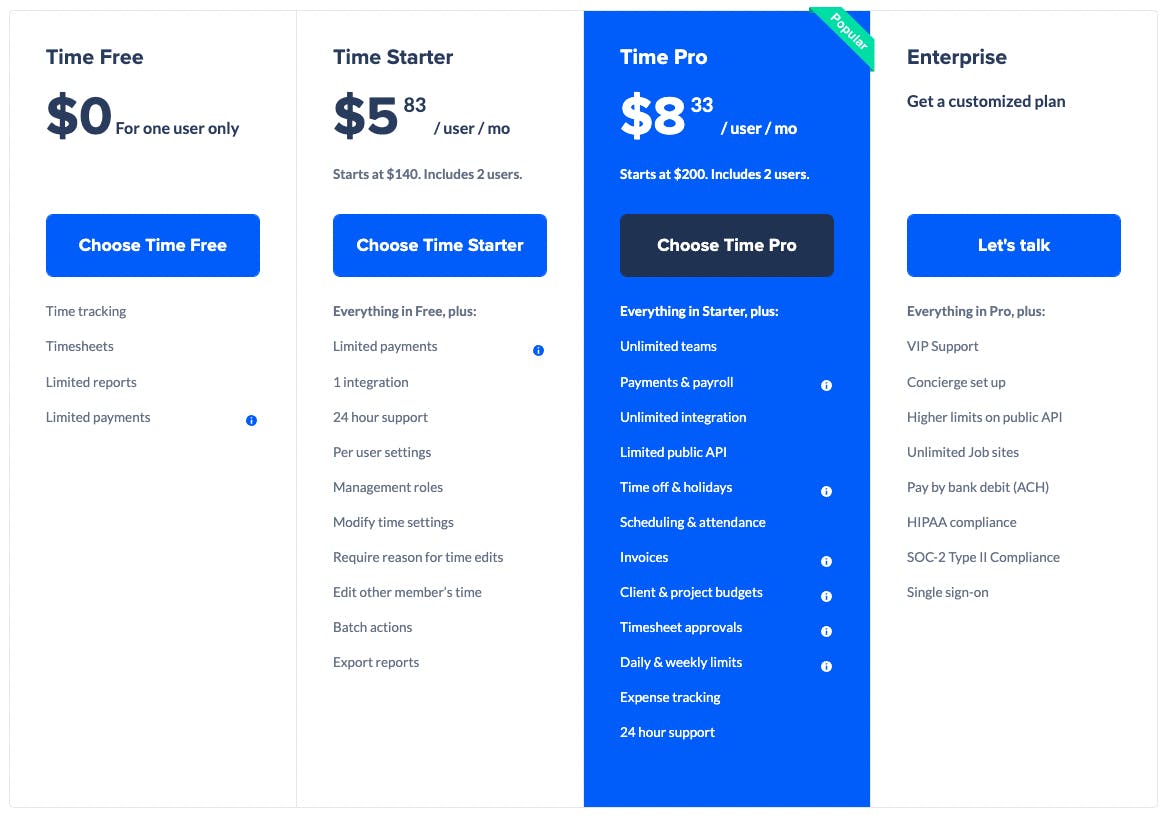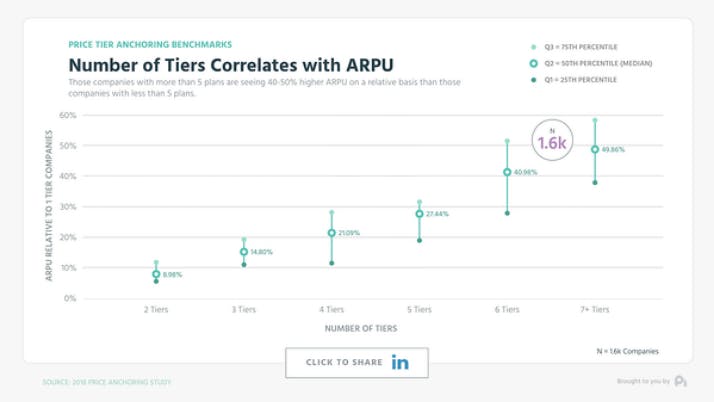Here at Paddle, we’re pretty keen on pricing. We’re always available to talk about pricing. Doesn’t matter who you are or what you’re selling, if it’s pricing, we’re interested.
That’s because your pricing structure is absolutely definitive for your business. Where you go with pricing structure will define not only your approach to your price points but also your packaging and discounts throughout your business. Developing a solid pricing structure is the first step to optimizing your pricing, and optimized pricing can be a wicked (and often overlooked) growth lever for your business.
What is a pricing structure?
Your pricing structure defines your pricing setup for products or services, including your core price points plus discounts, offers, and strategy. It fundamentally answers the question, “How much do I charge for my product?” by helping you figure out the relationship between the value of your product or service (and especially how your customers perceive that value) and the costs incurred to create and provide it.
Your pricing structure is powerfully influential over how your company is perceived from the outside and how fast it’s likely to grow. A company with a solid grasp of their buyer personas and the competitive value of their product charges a fair price. That equals big growth.
Every pricing structure begins with a pricing objective. Change the objective, and you’ll have to change the structure, too. Whether you’re attempting to break into a competitive field, hawking a high-value and very innovative product, catering to a broad array of buyer personas, or playing to a narrow field, adapt your pricing structure accordingly.
Pricing structure vs. pricing strategy: What’s the difference?
You might expect to see written below a whole host of pricing strategy buzzwords: penetration pricing, price skimming, product line pricing. However, a pricing strategy is not the same as a pricing structure.
Pricing structure
Involves your whole approach to pricing across your company but with a specific emphasis on how your pricing relates to the features of your product being made available and how it affects customer use of your product.
Pricing strategy
Less concerned with your customers than it is with the competitiveness of your product in the market. Even with original products that have value, you will almost certainly have competition in the market. Pricing strategy concerns the method of setting your price points in a way that establishes your product as competitive in the eyes of potential buyers.
Unsurprisingly, the terms are related. Pricing strategy is the market-facing part of your pricing structure and (as we’ll see below) should complement your pricing structure. You can find out more about pricing strategy here.
Why pricing structures are so important
Once your product is ready for market, your first priority is to ensure that the right customers are made aware of its value, and that, once those customers buy-in, they can benefit from the value they’ve paid for. A good pricing structure can do both.
It is complementary to your pricing strategy
Understanding who you’re selling to and how to package your product are key parts of your pricing structure and play a major role in the development of your pricing strategy, too.
Cornering your market share has a lot to do with understanding how your product features appeal to your buyer personas. The word ‘features’ is important — unless your product has a very narrow focus, and you’re only catering to a niche buyer, it’s likely that different features of your product will appeal to different potential customers. That’s particularly true when you’ve got a very broad-use product, like Paddle's ProfitWell Metrics (our software helps you achieve faster recurring revenue growth) or Wistia (provides simple software for creating, managing, and sharing videos for business).
Developing a crack product pricing strategy requires knowing just who finds your product appealing.
It can pull or push away customers
It’s easier, and more helpful even, to think of your pricing structure as a method of presentation. It strongly influences the way your customer will perceive the value of your business.
A well-developed pricing structure will attract the right kind of customers: those who find your product/service useful. It repels those who are likely to cancel a month after signing up upon discovering that they need something else. For example, if you’re using tiered pricing, a good pricing structure will not only divide feature availability according to buyer personas, it will also make the distinctions between tiers clear.
Below is the pricing page for Hubstaff.

The page clearly shows what features are available in which tier. They have a very wide user base, so a little more explanation on how each tier could benefit each potential buyer persona would make this already-effective demonstration of their pricing structure even more appealing.
Plus, a clear pricing structure that lets your buyer know exactly what to expect makes onboarding — one of the most high-risk stages of the customer journey — go smoothly. It’s even more important in making sure the customer gets all the value out of your product that they paid for. Think of a good pricing structure as an anti-churn device!
Using pricing as a growth lever
Monetization is much more than just a way of positioning your product - it’s one of the most important pricing levers in business today, and yet this fact is seldom recognized. The amount of businesses talk about acquisition compared to retention and monetization illustrates that clearly (see chart left).
Finding the right pricing structure will pay off big time. The average SaaS company spends less than 10 hours updating its pricing every year — but more time invested in pricing can give you huge returns.
If the pricing’s right, your product can fully make the most of its inherent value.
Shopify has the right number of tiers to simultaneously give them coverage of different buyer types and provide room for upselling later, all the while maintaining focus on serving the key areas of their market base.
It’s true that having a higher number of tiers can lead to certain empirical advantages, like a higher ARPU, as we can see here.

Companies with more than five plans are seeing 40-50% higher ARPU on a relative basis than those companies with fewer than five plans.
However, that doesn’t necessarily mean you should swamp a prospect with a 10-tiered structure. Too much choice, especially if your feature range is narrower or your buyer personas not as numerous, can actually turn off a potential buyer. Consider simplifying the initial conversion with two to three tiers on your new customer pricing page, and then give them a wider array of options when they’re upgrading later.
3. Variable pricing
Variable pricing is on offer if part of a company’s selling line involves words to the effect of “Contact us for more information on pricing.” A company working from a variable pricing model seeks to negotiate a specific price for each customer who needs their services.
This pricing structure is most useful for specific software or software that comes at a financial premium. Similarly, if your product is in-demand in areas that require deployments of varied scale — for instance, if you’re approached by companies with five employees as well as those with 500 — you might find variable pricing useful for both maintaining a broad market appeal and getting the most out of larger clients.
Variable pricing is not to be confused with “usage pricing,” which we’ll be covering shortly.
4. Tiered and variable
A company employing this hybrid pricing structure uses tiering as a basis for pricing with ‘regular’-sized customers. The benefits of tiered pricing are retained. Meanwhile, the addition of a variable option gives the business room to negotiate rates and cut customized deals with customers who fall outside of their usual range.
The tiered and variable pricing structure is the most complex on our list, but it can be effective when you have a consumer-facing product that is also used by specific business fields. Consumers have a range of options to choose from, while bigger businesses can negotiate for rates and even specific feature packages.
5. Per-user pricing
Per-user pricing is a simple, highly popular pricing structure that is extremely well-liked among SaaS subscribers. In per-user pricing, a single user pays a fixed monthly price. They may then add another user to their plan, and the baseline price increases (it might double, for instance); a third user increases the price by the same token, and so on.
Its main virtue — being linear — is why per-user pricing is best suited for simpler products with a smaller feature array. It’s easy for customers to understand what they're paying for in this instance, and just as easy for companies to manage and predict their revenue. As with flat-rate pricing, however, it's not easy to tap into the value of differing buyer needs to maximize your growth potential.
6. Usage-based pricing
This pay-as-you-go type model relates the cost of a SaaS product to its usage.
This is particularly effective for infrastructure- and platform-related software, such as Amazon Web Services and other services where companies are charged for smaller transactions within the product (e.g., API requests, transactions processed, or data used).
Usage-based pricing is for companies working in price sensitive market areas, as customers will always be able to justify the change in price. From the perspective of a subscription company, usage-based pricing is not ideal. It makes it difficult, however, for companies using it to make concrete revenue forecasts.
7. Freemium
Ah yes, freemium.
Hugely popular with meteorically successful SaaS companies, from Dropbox and Slack to Yammer and Skype, freemium dovetails excellently with the tiered pricing model. Entry-level access to product features is kept free, with increasing restrictions on higher-level features to incentivize upgrading.
It’s particularly good for very sticky products (like those mentioned) that get customers eager to upgrade, even though it requires taking an initial financial hit.
Freemium is a versatile pricing structure: restrictions can be made on the basis of feature or capacity and use case. Plus, there are seven different types of freemium structures.
4 tips for building a strong structure
1. Understand your product’s value before determining price
Never decide on your pricing before you have a finished product. Let the product speak for itself; be reactive to the behavior and feedback of your initial customers before changing your monetization approach.
Remember, differing features within your product will be defined by customers’ perception of them — just because Feature A and Feature B are in the same package doesn’t mean that they’re equivalent in value or in customers’ willingness-to-pay (WTP) for them. Observe early patterns and adjust accordingly.
2. Make it simple
When drawing up your pricing structure, think about the last time you had all those different membership options down at the gym presented to you, then do the exact opposite of that. Keep it simple.
Clearly outline your tiers, their content, and help guide your different buyer personas towards the tier that’s best for them. As noted above, nesting tiers — a base range for new customers, more for upgrading customers — can ease the process. Ensure that the steps from purchase to onboarding are also well-laid-out. You know your pricing strategy is successful when happy customers eagerly inquire about upgrading, not when they hit ‘Purchase’ the first time.
3. Be flexible
Flexibility, re-evaluation, and a sense of dynamism when dealing with pricing strategy are fundamental. Your strategy is not totemic — it has to change as your product does.
We’ve seen it proven that companies that switch up price points every six months see notable ARPU increases compared to those that evaluate pricing once per year or less. Make sure your pricing scales alongside your product’s own improvements. A vastly expanded product with new and improved features and last year’s price points will actually be losing you revenue per sale relative to its value — don’t be afraid to increase your price points!
4. Make it scalable
Young subscription businesses can sometimes be overeager to please a customer base they haven’t even won yet. To a degree, the truism that low price = good value applies in the SaaS world, too. However, your pricing structure needs to value your product every bit as much as it needs to be realistic for your customers.
If you begin with a low, fixed price, you may find yourself missing out on additional revenue from customers with a higher-willingness-to-pay who value your product at a higher rate than its pricing. Alternately, a static pricing option may harm your product’s credibility (if the pricing’s too low) or turn off a prospect who only needed part of your functionality (if it’s too high).
The success of your product does not solely depend on the quality of service you’re bringing with it. It’s your pricing structure that will present your product’s value to customers in a way that they’ll understand; it’s not something to leave to chance, and yet it’s something so many businesses neglect.
Analyze your product’s position in the market and who you want to target, and plan your pricing structure accordingly. Getting the balance right between a price that drives you forward and a price that customers can’t resist is never easy — but with the right time and care, it’s possible.




